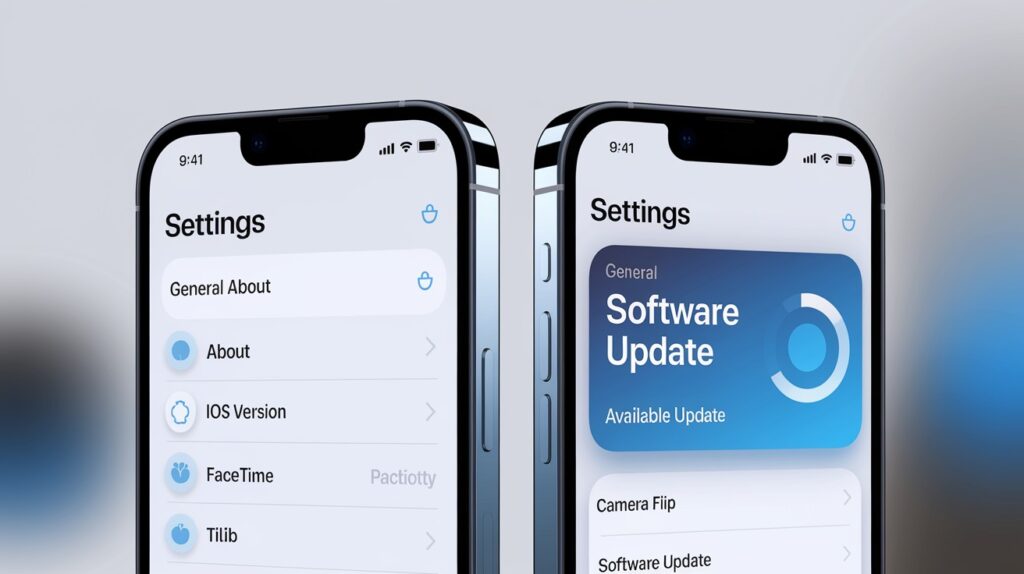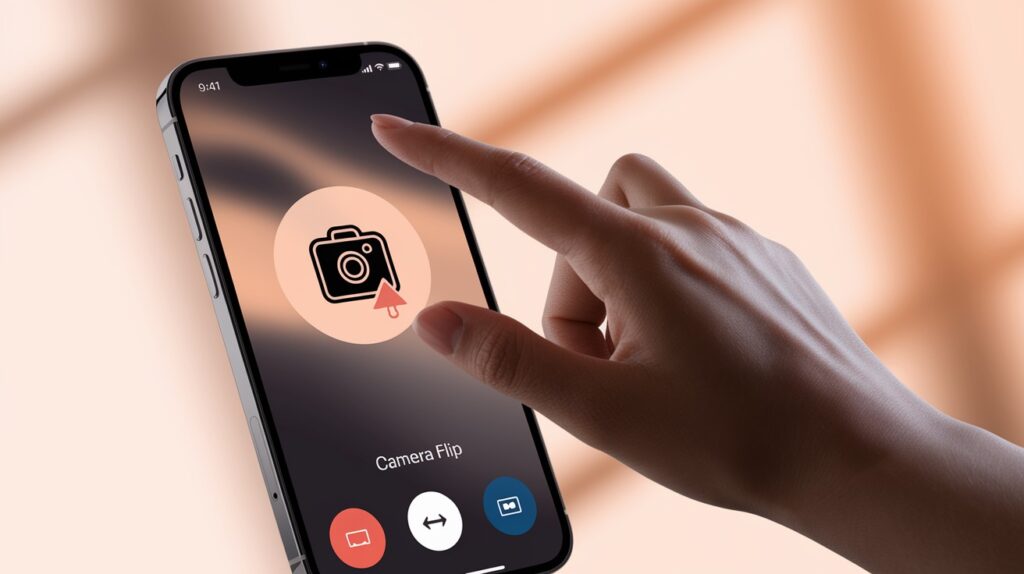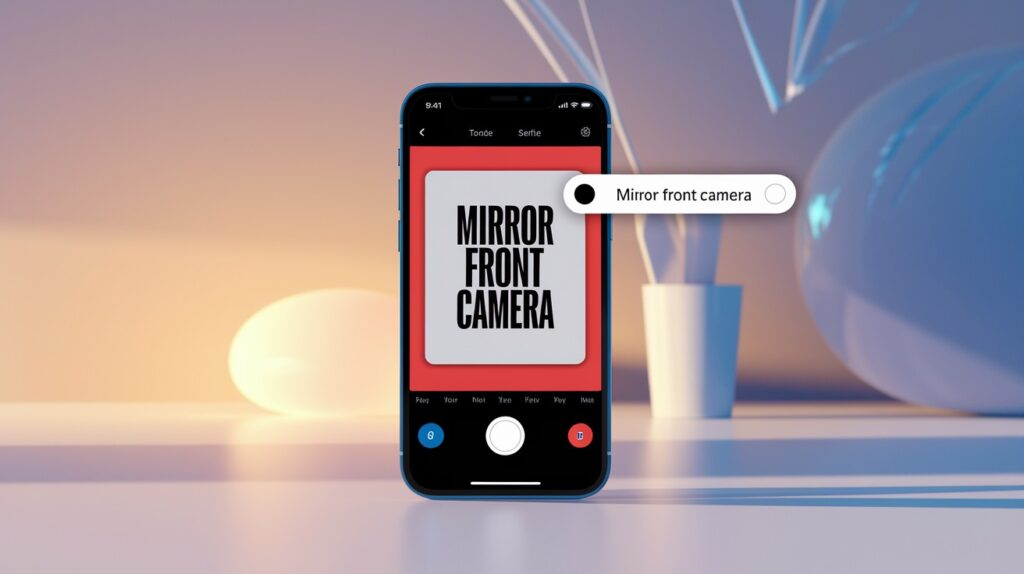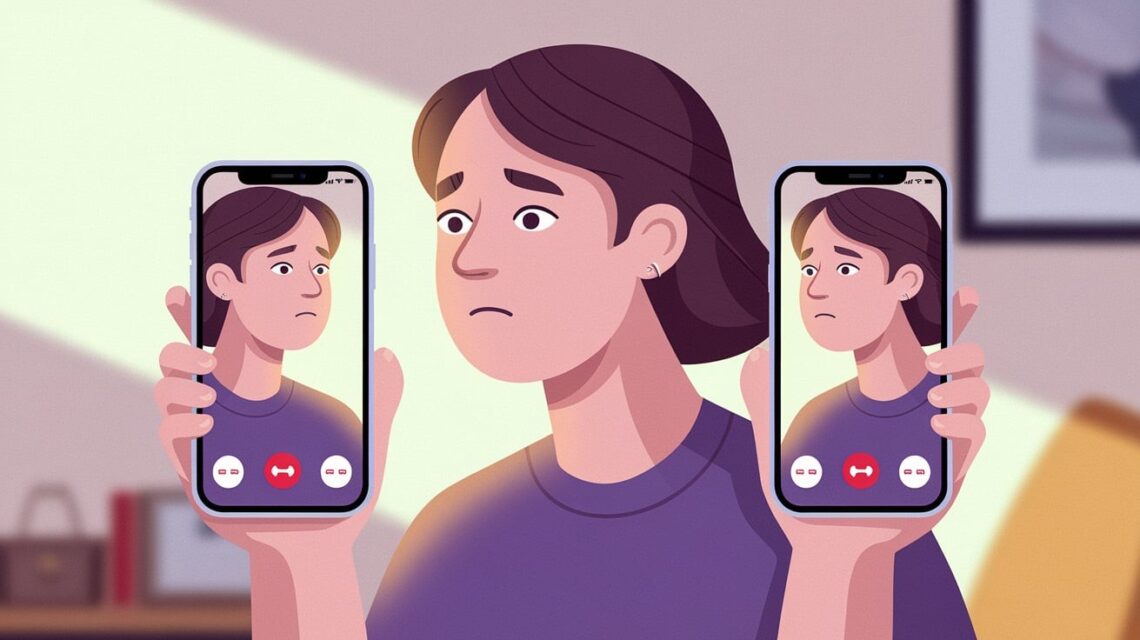Have you ever started a FaceTime call and thought, “That’s not how I look”? You’re not alone! The way FaceTime displays your face can be confusing.
“I just want to see myself how others see me!” is a common frustration. Fortunately, there are solutions.
In this guide, we’ll explain what “inverting” your camera means on FaceTime, why it matters, and provide clear instructions for iPhone, iPad, and Mac.
If you’re concerned about how your hair looks or want a more natural video chat experience, these simple tips will help you control your on-screen appearance during your next FaceTime conversation.
Let’s understand what “inverting” actually means and why it might matter to you!
What Does “Invert Camera” Mean in FaceTime?
|
Term |
Definition |
What You See |
What Others See |
|
Mirror |
Your image appears reversed (like in a mirror) |
Text appears backward, parts on the left appear on the left |
Normal orientation, text readable, parts on left appear on right |
|
Flip |
Changing the horizontal orientation of the video |
Horizontally reversed image |
Depends on when/how the flip occurs in transmission |
|
Invert |
Can refer to either mirroring or switching between cameras |
Depends on the context – either the mirror effect or changing from the front to the rear camera |
Unchanged if switching cameras; depends on settings if mirroring |
|
How FaceTime Shows Your Video |
What You See (Self-View) |
What Others See |
|
Default Display |
Mirrored view (like looking in a mirror) |
Non-mirrored view (how you appear) |
|
iOS 14+ Mirror Option |
Can turn off mirroring to see yourself as others do |
Always see you in normal orientation |
|
Front Camera |
Typically mirrored by default |
Normal orientation |
|
Rear Camera |
Not mirrored |
The same view you see on your screen |
How to Invert Camera on FaceTime for iPhone and iPad?
1. Checking iOS Version Compatibility

To use camera inverting features on FaceTime, your device needs iOS 14.2 or later.
Go to Settings > General > About to check your current iOS version. If you’re running an older version, update through Settings > General > Software Update to access all camera features.
2. Steps to Switch Between Front and Rear Cameras

- Start or answer a FaceTime call on your iPhone or iPad. Look for the control panel at the bottom of your screen with various call options.
- Locate the camera flip icon (it looks like a camera with rotating arrows) in the control panel. Tap this button to switch immediately between your front-facing and rear-facing cameras.
- To access more camera controls during your call, swipe up from the bottom of the FaceTime interface. This reveals additional options that may include video effects depending on your iOS version.
3. Using Third-Party Apps for Mirror/Flip Effects

- Camera+ 2 offers advanced camera controls, including mirror functions that can be used before joining FaceTime. This app lets you capture and save mirrored photos/videos that display exactly how you want them to appear.
- Perfect Video provides comprehensive video editing tools that allow you to flip your recorded videos horizontally. You can record yourself, edit the orientation, and then use this as input for FaceTime.
- Zoom has built in a mirror of my video settings that some users prefer. You can start a Zoom meeting, adjust your camera settings, and then switch to FaceTime with those preferences already configured.
- Filmic Pro gives professional-level control over your device’s camera, including image orientation options. Though primarily for recording, it can help configure how your camera behaves in other apps.
- Mirror for Samsung TV and similar screen mirroring apps can display your FaceTime call on larger screens while also offering image flip options. This provides a workaround for controlling how your video appears.
4. Using iOS Camera Settings Before a FaceTime Call

Open your Camera app before starting FaceTime and check the mirroring settings. Tap the arrow at the top of the screen, then look for the mirror front camera option.
Enabling this setting affects how photos are saved, and while it doesn’t directly change FaceTime, it helps you understand how you’ll appear.
For best results, take a test photo with text to see orientation, then start your FaceTime with clear expectations of how you’ll look to others.
How to Invert Camera on FaceTime for Mac?
1. Switching Cameras During a FaceTime Call on macOS
When using FaceTime on your Mac, switching between cameras is straightforward if you have multiple cameras connected.
During an active call, click on the video menu in the FaceTime window. A dropdown list will appear showing all available cameras connected to your Mac.
Simply select the camera you want to use from this list. If you’re using a MacBook with only the built-in camera, you won’t see camera switching options unless you connect an external webcam.
2. Using Built-In macOS Camera Effects
macOS offers some built-in camera controls through the FaceTime app. During a call, click on the Effects button (usually appears as a star icon) in the control panel.
This opens a panel with background effects and filters. While macOS doesn’t have a dedicated “mirror” button, you can use Portrait mode, which sometimes adjusts how your image appears.
For more camera options, click on Video menu > Video Effects to access additional settings that might affect your camera orientation.
3. Adjusting Image Orientation via External Camera Apps
Mac users have several options for controlling camera orientation outside of FaceTime’s limited settings.
Photo Booth, included with macOS, allows you to flip your camera image horizontally before starting a FaceTime call. Simply open Photo Booth, adjust your camera settings, and then launch FaceTime.
CamTwist Studio is a powerful third-party application that functions as a virtual camera. Install it on your Mac, configure mirror settings, then select CamTwist as your camera source in FaceTime preferences.
OBS (Open Broadcaster Software) with the Virtual Camera plugin gives you professional-grade control over your video feed. You can mirror your webcam in OBS, then use this modified feed in FaceTime.
ManyCam and similar webcam software create virtual cameras with extensive customization options, including horizontal flipping. These programs let you modify your video before it reaches FaceTime.
For Mac users with external cameras like Logitech webcams, the manufacturer’s control software often includes image flip options that affect all applications using that camera, including FaceTime.
Common Issues When Trying to Invert Camera on FaceTime
- Camera Switch Button Not Responding – Tapping the flip camera icon shows no change in your view. This often happens due to temporary system glitches.
Try closing FaceTime completely (swipe up from the bottom on newer iPhones or double-click the home button on older models), then restart the app and call again.
- Camera Options Greyed Out or Missing – Camera controls appear dimmed or unavailable during your call. This typically occurs when using an older iOS/macOS version that doesn’t support all camera features.
Update your operating system, or check if your device meets the minimum requirements for camera switching.
- Video Feed Freezes After Camera Switch – Your FaceTime call freezes or shows a black screen immediately after trying to flip cameras. This indicates a processing issue.
Ensure your device has sufficient free memory by closing background apps, and check your internet connection stability, as switching cameras requires bandwidth.
- Front Camera Always Returns to Mirror Mode – Your settings don’t seem to stick between calls, always reverting to default mirror mode.
This happens because FaceTime saves mirror preferences on a per-call basis rather than globally. You’ll need to adjust settings at the beginning of each new call.
- External Camera Not Recognized for Switching – On Mac, your additional webcam doesn’t appear in the camera selection menu.
Verify the external camera is properly connected, check if it requires specific drivers, and ensure you’ve granted FaceTime permission to access all cameras in System Preferences > Security & Privacy > Camera.
- App Crashes During Camera Transition – FaceTime closes unexpectedly when attempting to switch cameras. This suggests a more serious software conflict.
Try restarting your device completely, and if problems persist, reset FaceTime settings by going to Settings > FaceTime > Toggle FaceTime off, wait 30 seconds, then toggle back on.
How Inverted Camera Affects Your Video Call Quality?
1. Does It Change the Resolution or Orientation?
Inverting or flipping your camera in FaceTime doesn’t typically affect the actual resolution of your video feed.
The pixel count and image clarity remain the same whether mirrored or not. However, switching between front and rear cameras can impact quality, as most devices have higher resolution rear cameras.
What does change is purely the horizontal orientation of the image, like looking in a mirror versus a photo. Text appears reversed in mirrored mode, and items on your left appear on the left side of the screen (instead of on the right side, which is how others would see you). This is simply a display change rather than a technical quality reduction.
Suppose you notice any quality drop after flipping cameras. In that case, it’s more likely due to the processing power required for the switch or related to internet bandwidth limitations rather than the flip itself.
2. Viewer Perspective vs. Self-View
|
Aspect |
Your Self-View (Default) |
How Others See You |
Impact on Communication |
|
Text/Writing |
Appears backward when mirrored |
Always reads correctly |
Important when showing documents or text during calls |
|
Gestures |
Pointing left appears on the left side of the screen |
Pointing left appears on the right side of their screen |
Can confuse instructional calls |
|
Facial Asymmetry |
Shows the face you’re used to seeing in mirrors |
Shows your face as it appears in photos |
It may affect confidence if you prefer your mirrored appearance |
|
Background Items |
Reversed from the actual room layout |
Matches the actual room layout |
Relevant when referencing objects in your environment |
|
Psychological Comfort |
Most people prefer seeing themselves mirrored |
Others always see the non-mirrored view |
Self-consciousness is often lower with a mirrored self-view |
|
Movement Tracking |
Moving right appears as moving right on the screen |
Your right movement appears as moving left on their screen |
It can affect coordination in movement-based conversations |
3. Inverted Camera in Portrait and Landscape Modes
When using FaceTime in portrait (vertical) orientation, camera inversion only affects the horizontal mirroring of your image.
The top and bottom of your frame remain unchanged, and the aspect ratio stays consistent with your device’s natural orientation.
Switching to landscape (horizontal) mode introduces additional considerations. In landscape, not only does the mirroring effect continue to work the same way horizontally, but the entire frame rotates to accommodate the wider view.
Some users report that landscape orientation makes the mirroring effect less noticeable since the wider frame changes your visual reference points.
An important note: on some devices, particularly older models, switching camera orientation while also in landscape mode can sometimes cause temporary glitches where the image appears incorrectly oriented for a few seconds before correcting itself.
For optimal video quality in either orientation, the key factor isn’t whether your camera is inverted but rather ensuring you have adequate lighting and a stable internet connection.
These factors impact video quality far more significantly than any orientation settings.
Conclusion
Understanding how to control your camera on FaceTime puts you in charge of how you present yourself during video calls.
While Apple’s default settings mirror your self-view (showing you what you’d see in a mirror), you now have the tools to change this experience.
Whether you switch between front and rear cameras, use third-party apps for more control, or try our suggested workarounds, these techniques help create a more comfortable video calling experience. Remember that camera orientation doesn’t affect actual video quality, just how the image is displayed.
Keep in mind that common issues like frozen screens or greyed-out options usually have simple fixes. With these tips in hand, you can focus on what truly matters: connecting with friends, family, and colleagues through clear, personalized video calls.
Frequently Asked Questions
Why does FaceTime flip my image?
FaceTime mirrors your self-view by default, so it feels natural, like looking in a mirror. Others see you normally.
Can I permanently change the mirror setting?
No, FaceTime resets mirror preferences for each call. You’ll need to adjust settings at the start of every call.
Will flipping my camera affect video quality?
No, flipping only changes image orientation, not resolution or clarity. Quality depends on your connection and lighting.








